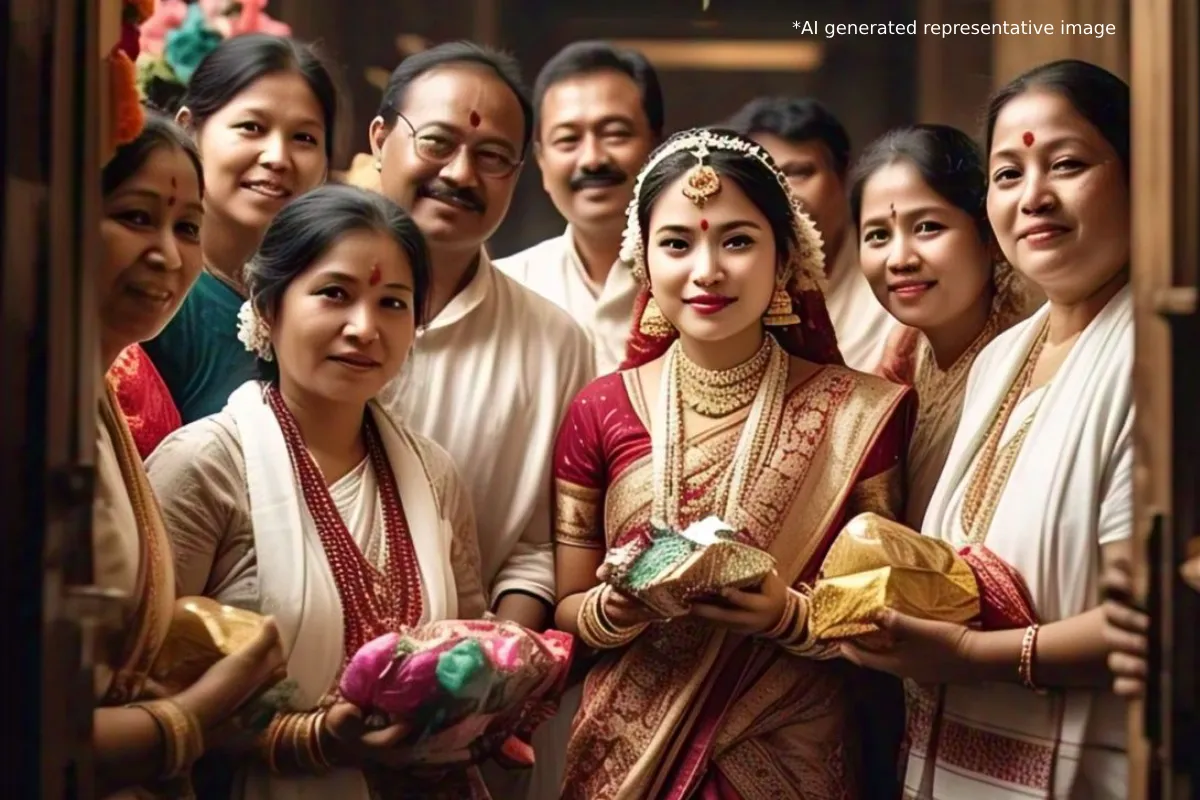Let’s explore an Assamese pre-wedding custom called Jurun and find out all the activities that complete a traditional Assamese wedding.
Updated on :
Share this post
Typically, a Jurun takes place one or two days prior to the wedding and perhaps even on the day of the wedding. This custom involves the groom’s family, particularly the women, visiting the bride’s family to show off the bridal attire, accessories, jewelry, and makeup. In a sense, it’s a custom that welcomes the bride to her new family with gifts, blessings, and love.

“Ulai aaha Aidew e, nokoriba Laaz e,
tumar babe roi aasu, xomaj ore maaje”
” Come out dearest, don’t be shy, we’re waiting for you among all the guests”
An Assamese wedding is overall a celebration of love, unity, and heritage. It is comprised of several ceremonies and rituals, and each symbolizes something different. Jurun is a unique pre-wedding custom that is also known in Assamese as Tekeli diya. Tekeli is the auspicious pot that is given to the bride by the groom’s family. But that’s not it; it is quite a long ceremony involving both families.
Let’s look at the series of events taking place at Jurun and find their significance.
Aam Dali gutha, or a string of mango leaves, is customarily tied over the door on the day of Jurun. It is thought to purify the newlywed of all negative energy and bring them luck.
Jurun is generally organized in the morning. The guests who come for the Jurun bless the groom and his family before they leave for the bride’s house. The groom doesn’t accompany them.
Things that are given to the bride
Two small bell metal vases (called luta in the Assamese language) are filled with water and tied with string, and also a Xarai (Assamese traditional tray) is carried to the bride’s place and kept there until the marriage takes place.
The groom’s family also carries dessert and snacks for the bride’s family. The most important items that the groom’s family carries are a whole fish, an ash guard, which is put inside a handcrafted bamboo vase called a Tum, and a bunch of areca nuts.
During Jurun, they carry the wedding outfit, which is the paat silk Mekhela Chador, that the bride would wear during the marriage, along with other outfits, footwear, jewelry, and makeup accessories.
Exchange of rituals
When the groom’s family arrives at the bride’s house, the bride’s mother and the rest of the family, especially the women, greet them with love and respect. They give each other a hug and exchange Xorai (Assamese trays), then they are led to the venue and seated.
Once seated, the groom’s family presents all the assets in front of all the members and elderly people present there. Typically, everyone sits on the ground after the bride arises, with the bride occupying the center seat.
As the bride arrives, the women encircle her and start with murot tel diya, which means to put some oil on her hair through arena nut. A holy ululation sound is made (Uruli diya). It is customary to lay a ring on the head and pour oil through it while applying oil. The dresses are then piled on top of the Xorai one by one. It’s important that the bride touches each piece of jewelry and clothing as she stacks them. The bride typically dons every piece of jewelry that the groom’s relatives gave her.
The most important custom that follows is the groom’s mother putting sindoor (vermilion) on the bride’s forehead. It is a symbol of wifehood and a welcoming gesture as a daughter-in-law.
The chadar of the main outfit, which is the white and gold bridal paat silk set, is put on the head of the bride, and while putting on jewelry and chadar, ladies sing Biya Naam (a folk song sung during weddings), a fundamental custom connected to Jurun.
Following the completion of the ceremony, the bride and groom’s mother receive blessings from all those in attendance. This is one method the bride is introduced to the groom’s family and extended circle of friends.
Things that the groom’s family take home
Just like the groom’s family brings different things for the bride, it is a tradition to take things home as well. The bride sends the groom’s outfit, which is a dhoti, kurta, cheleng chadar, shoes, and other essentials, along with sweets.
From the two metal vases, one is kept at the bride’s house and the other is taken. The water filled in that vase would be used to bathe the groom during a ritual called pani tula.
After the completion of all the rituals, the groom’s family and all the guests enjoy their lunch.
Significance of Jurun
The Jurun is a centuries-old Assamese ritual. It serves as a display of welcoming the bride and a ceremonial acceptance of the wedding by both families. The other ceremonies cannot begin until this ceremony is completed. Jurun is the mark of the bride’s acceptance by the groom’s family, who show her love by giving her presents, primarily clothing and accessories.
The occasion, which reflects Assamese cultural values and the joining of two families, is a joyous celebration with traditional music, food, and prayers. Simply put, this celebration symbolizes the warmth and respect that are essential to Assamese weddings. It establishes a positive tone for the wedding ahead.
Endnotes
Wedding rituals differ from region to region. Some customs are similar, and some may be done in a different way, but the meaning of Jurun remains the same, which is to present the gifts to the bride and adorn her with the bridal essentials. It is to welcome the bride in the groom’s family with love and admiration.

Rimjim Bora is a passionate researcher, writer, and storyteller. Being an Assamese, she takes pride in writing the vibrant stories of Assam, sharing its essence beyond the region. Contact Rimjim at rimjim@diversityassam.com.


